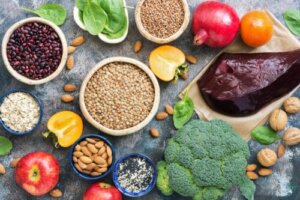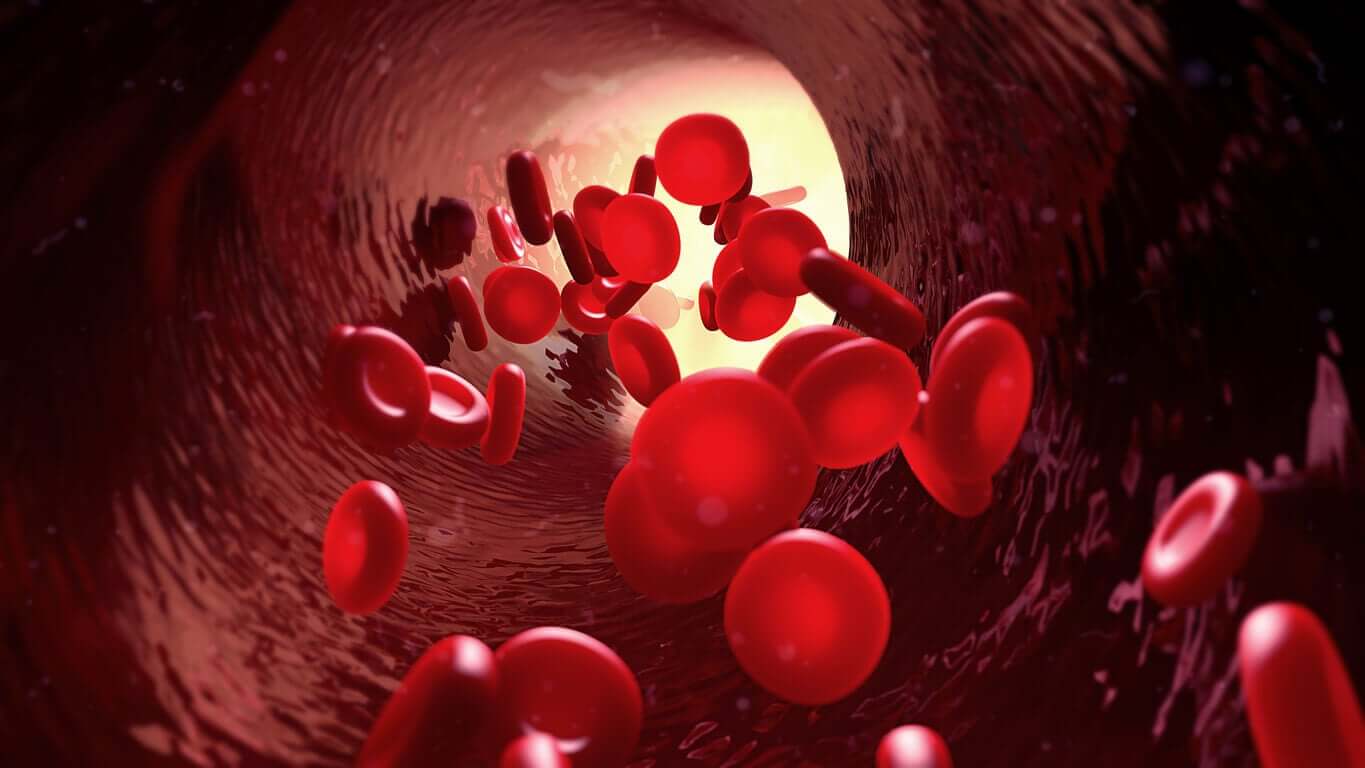7 Foods to Fight Childhood Anemia

Do you know that there are several types of anemia depending on the nutrient deficiency? You usually hear about iron deficiency, since it’s the most prevalent in children, but vitamin B12 and folic acid deficiencies can also cause this disease. Next, we’ll tell you which are the best foods to combat childhood anemia.
What is childhood anemia?
Anemia is a disease of the blood, characterized by low levels of red blood cells. The function of these cells is to transport oxygen from the lungs to the rest of the tissues.
When the number or shape of these globules isn’t adequate, their work isn’t entirely efficient. Consequently, the child may experience certain symptoms, such as tiredness, dizziness, paleness, or difficulty concentrating.
Inside the red blood cell is hemoglobin, which is the molecule in charge of adhering to oxygen to distribute it throughout the body. This union depends on the presence of iron, which in turn gives these cells their characteristic red color. When the body’s levels of this mineral fall below the desirable limit, the body develops a type of anemia called iron deficiency.
For their part, vitamin b12 and folic acid participate in the structure and production of red blood cells and both are obtained from food. If the intake of one or both is insufficient, blood levels decrease, and consequently, these cells adopt an abnormal shape that prevents them from functioning properly. This type of anemia is known as megaloblastic.

Combat childhood anemia through the intake of these foods
Given the suspicion of anemia, the pediatrician may request certain studies to know the severity and type of disease that the child presents.
Based on these data, they’ll indicate therapeutic measures that include some favorable changes in the diet. Among them, the incorporation of the following foods in the dietary guideline. Take note!
1. Clams
These are considered one of the best sources of iron, but they also contain lower amounts of vitamin B12. Therefore, a single serving per day achieves the recommended daily intake (RDI) of these micronutrients.
These seafood are often very appreciated by children and can even be bought canned. Keep in mind that it’s important to steam them in a covered pot, to remove the remains of earth contained inside.
2. Red meat
In addition to being an excellent source of protein, meat is rich in iron and vitamin b12.
Iron from this animal source is usually better absorbed than that from plant origin. However, kids should only consume it only 1 or 2 times a week.
3. Lentils
Legumes are also a good source of iron. Not only do they have a high concentration of this mineral, but they also contain phytates that favor its absorption in the intestine.
For this reason, it’s advisable to soak them at least 24 hours before cooking or even let them germinate and include them in salads. Another option for cooking lentils is to mash them so that the walls break and release the iron more easily. Have you tried offering your children hummus or any legume paté?
Finally, lentils contain folic acid (folate) in large quantities. But you must take into account that this vitamin dissolves in water, so it’s very appropriate to prepare them in stews and consume the broth itself.
4. Fish
In regard to clams or cockles, the iron concentration of this meat is low. However, it’s a source of vitamin b12 and very healthy fatty acids, such as omega 3.
Experts recommend including fish in the diet at least 3 or 4 times a week, with the precaution of limiting the intake of large blue species as much as possible. This guideline comes from the Spanish Food Safety Agency.
5. Eggs
These foods are a good source of iron and vitamin B12, as well as vitamin A, biotin, and protein.
Although they contain a lot of cholesterol, it’s barely absorbed by the lecithin that’s abundant in the eggwhite. Boiled, in an omelette, or scrambled, eggs are often irresistible for little ones.
6. Nuts
Apart from omega 3, these foods provide a good amount of iron (pine nuts and pistachios) and folic acid (almonds and walnuts).
Toasted preparations facilitate the absorption of iron, but decrease that of folate. Therefore, it’s good to know which of the two nutrients you should improve in order to choose the best way to prepare food.
One of the biggest benefits of nuts is that you only need a handful to get an appropriate intake of these micronutrients. You can incorporate them as sandwiches, in salads, or in baked goods.
7. Green leafy vegetables
These are an excellent source of folic acid. So, with a portion in your main meals, you already reach the recommended daily intake of this vitamin. As we’ve mentioned before, this micronutrient dissolves in water, so it’s much better to eat vegetables raw, steamed, or even sautéed with a little oil.
You don’t always need to use lettuce in salads, as you have other options such as watercress, lamb’s lettuce, arugula, spinach, endive, broccoli, and green beans.

Tips on foods to fight childhood anemia
To increase the absorption of iron from food, one of the main strategies is to ensure that there’s some source of vitamin C in the same meal.
For example, peppers, oranges, kiwi, or tangerines. Even a few drops of lemon juice can be enough. On the contrary, it’s important to avoid adding dairy products, as calcium hinders the intestinal absorption of iron.
As for vitamin B12, you should keep in mind that it’s only found in foods of animal origin, as it’s produced by the bacteria of the microbiota. Although there are vegetables, such as mushrooms and algae, that claim to contain it among their properties, it’s actually an analog of this vitamin that lacks functionality.
Now that you know which are the ideal foods to combat childhood anemia, it’s time to include them on your family table. Cook them in different ways and mix them with those that your little ones like the most!
Do you know that there are several types of anemia depending on the nutrient deficiency? You usually hear about iron deficiency, since it’s the most prevalent in children, but vitamin B12 and folic acid deficiencies can also cause this disease. Next, we’ll tell you which are the best foods to combat childhood anemia.
What is childhood anemia?
Anemia is a disease of the blood, characterized by low levels of red blood cells. The function of these cells is to transport oxygen from the lungs to the rest of the tissues.
When the number or shape of these globules isn’t adequate, their work isn’t entirely efficient. Consequently, the child may experience certain symptoms, such as tiredness, dizziness, paleness, or difficulty concentrating.
Inside the red blood cell is hemoglobin, which is the molecule in charge of adhering to oxygen to distribute it throughout the body. This union depends on the presence of iron, which in turn gives these cells their characteristic red color. When the body’s levels of this mineral fall below the desirable limit, the body develops a type of anemia called iron deficiency.
For their part, vitamin b12 and folic acid participate in the structure and production of red blood cells and both are obtained from food. If the intake of one or both is insufficient, blood levels decrease, and consequently, these cells adopt an abnormal shape that prevents them from functioning properly. This type of anemia is known as megaloblastic.

Combat childhood anemia through the intake of these foods
Given the suspicion of anemia, the pediatrician may request certain studies to know the severity and type of disease that the child presents.
Based on these data, they’ll indicate therapeutic measures that include some favorable changes in the diet. Among them, the incorporation of the following foods in the dietary guideline. Take note!
1. Clams
These are considered one of the best sources of iron, but they also contain lower amounts of vitamin B12. Therefore, a single serving per day achieves the recommended daily intake (RDI) of these micronutrients.
These seafood are often very appreciated by children and can even be bought canned. Keep in mind that it’s important to steam them in a covered pot, to remove the remains of earth contained inside.
2. Red meat
In addition to being an excellent source of protein, meat is rich in iron and vitamin b12.
Iron from this animal source is usually better absorbed than that from plant origin. However, kids should only consume it only 1 or 2 times a week.
3. Lentils
Legumes are also a good source of iron. Not only do they have a high concentration of this mineral, but they also contain phytates that favor its absorption in the intestine.
For this reason, it’s advisable to soak them at least 24 hours before cooking or even let them germinate and include them in salads. Another option for cooking lentils is to mash them so that the walls break and release the iron more easily. Have you tried offering your children hummus or any legume paté?
Finally, lentils contain folic acid (folate) in large quantities. But you must take into account that this vitamin dissolves in water, so it’s very appropriate to prepare them in stews and consume the broth itself.
4. Fish
In regard to clams or cockles, the iron concentration of this meat is low. However, it’s a source of vitamin b12 and very healthy fatty acids, such as omega 3.
Experts recommend including fish in the diet at least 3 or 4 times a week, with the precaution of limiting the intake of large blue species as much as possible. This guideline comes from the Spanish Food Safety Agency.
5. Eggs
These foods are a good source of iron and vitamin B12, as well as vitamin A, biotin, and protein.
Although they contain a lot of cholesterol, it’s barely absorbed by the lecithin that’s abundant in the eggwhite. Boiled, in an omelette, or scrambled, eggs are often irresistible for little ones.
6. Nuts
Apart from omega 3, these foods provide a good amount of iron (pine nuts and pistachios) and folic acid (almonds and walnuts).
Toasted preparations facilitate the absorption of iron, but decrease that of folate. Therefore, it’s good to know which of the two nutrients you should improve in order to choose the best way to prepare food.
One of the biggest benefits of nuts is that you only need a handful to get an appropriate intake of these micronutrients. You can incorporate them as sandwiches, in salads, or in baked goods.
7. Green leafy vegetables
These are an excellent source of folic acid. So, with a portion in your main meals, you already reach the recommended daily intake of this vitamin. As we’ve mentioned before, this micronutrient dissolves in water, so it’s much better to eat vegetables raw, steamed, or even sautéed with a little oil.
You don’t always need to use lettuce in salads, as you have other options such as watercress, lamb’s lettuce, arugula, spinach, endive, broccoli, and green beans.

Tips on foods to fight childhood anemia
To increase the absorption of iron from food, one of the main strategies is to ensure that there’s some source of vitamin C in the same meal.
For example, peppers, oranges, kiwi, or tangerines. Even a few drops of lemon juice can be enough. On the contrary, it’s important to avoid adding dairy products, as calcium hinders the intestinal absorption of iron.
As for vitamin B12, you should keep in mind that it’s only found in foods of animal origin, as it’s produced by the bacteria of the microbiota. Although there are vegetables, such as mushrooms and algae, that claim to contain it among their properties, it’s actually an analog of this vitamin that lacks functionality.
Now that you know which are the ideal foods to combat childhood anemia, it’s time to include them on your family table. Cook them in different ways and mix them with those that your little ones like the most!
All cited sources were thoroughly reviewed by our team to ensure their quality, reliability, currency, and validity. The bibliography of this article was considered reliable and of academic or scientific accuracy.
- Allali, S; Brousse, V; Sacri, A; Chalumeau, M; de Montalembert, M (2017) Anemia in children: prevalence, causes, diagnostic work-up, and long-term consequences. Expert Rev Hematol, 10(11): 1023-28.
- Ministerio de Sanidad, Servicios Sociales e Igualdad y AESAN. Base de Datos Española de Composición de los alimentos (BEDCA). Disponible en: https://www.bedca.net/bdpub/index.php
- Sun, J; Zhang, L; Cui, J; Li, S; Lu, H; Zhang, Y et al (2018) Effect of dietary intervention treatment on children with iron deficiency anemia in China: a meta-analysis. Lipids Helath Dis, 17(1): 108.
- Chandra, J; Jain, V; Narayan, S; Sharma, S; Singh, V; K Kapoor, A; Batra, S (2002) Folate and cobalamin deficiency in megaloblastic anemia in children. Indian Pediatr, 39(5): 453-7.
- Wang, M (2016) Iron Deficiency and Other Types of Anemia in Infants and Children. Am Fam Physician, 93(4): 270-8.
- AESAN. (2019) Recomendaciones de pescado por presencia de mercurio.
This text is provided for informational purposes only and does not replace consultation with a professional. If in doubt, consult your specialist.








